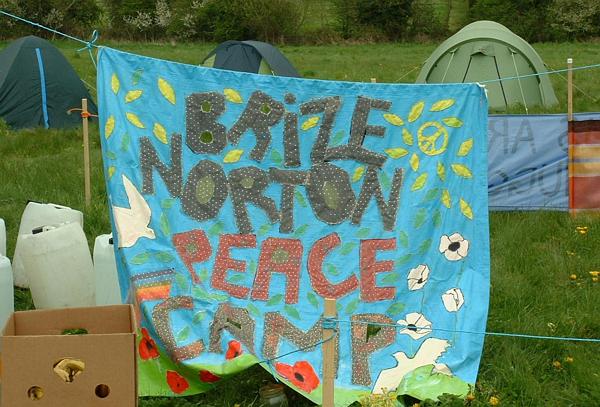
Brize Norton Peace Camp banner
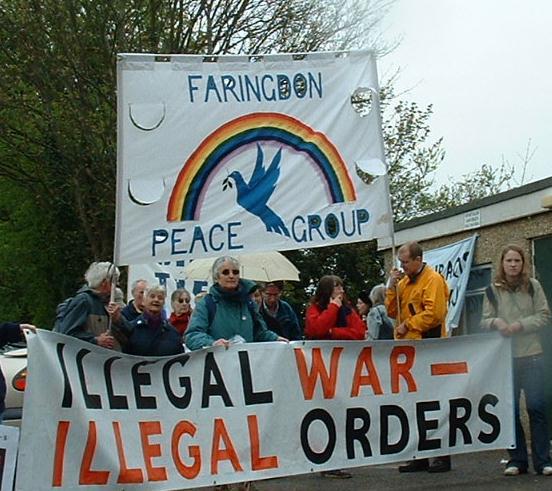
Illegal war – illegal orders
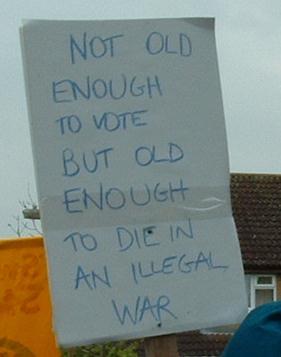
Not old enough to vote but old enough to die in an illegal war
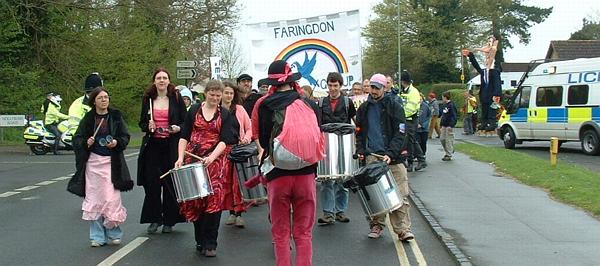
Breach of the Peace samba band
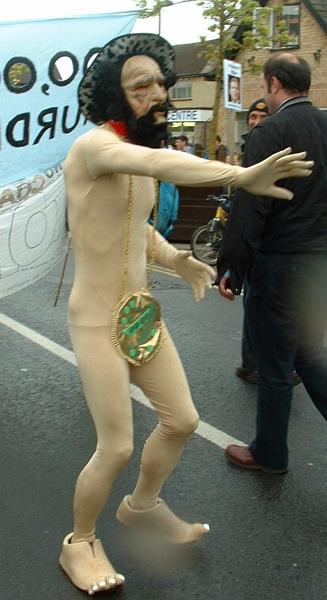
Dancing man – very popular with the kids
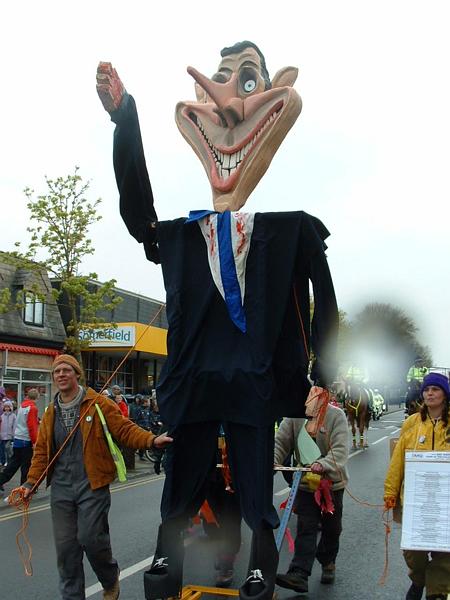
Giant statue of Tony Blair
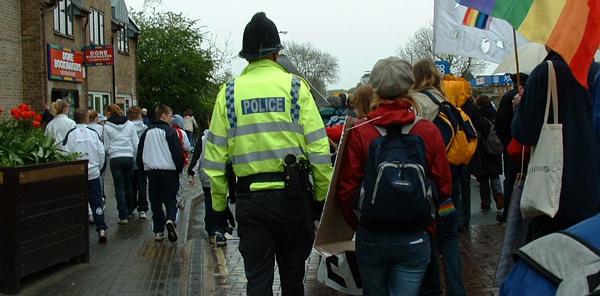
Local teenagers walk alongside the march
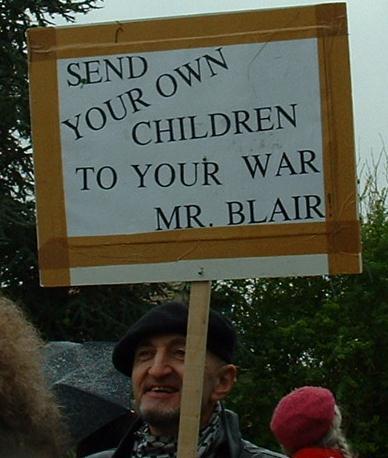
Send your own children to war Mr Blair
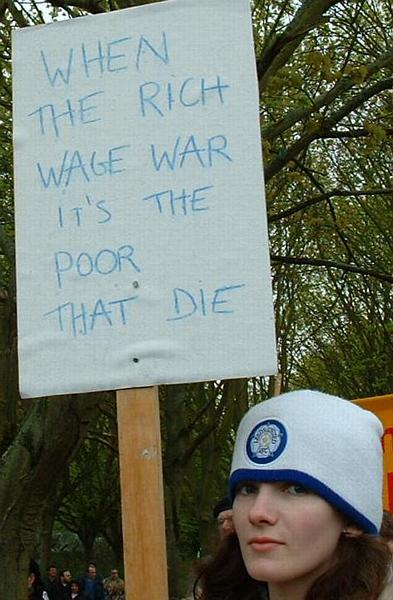
When the rich wage war it’s the poor that die
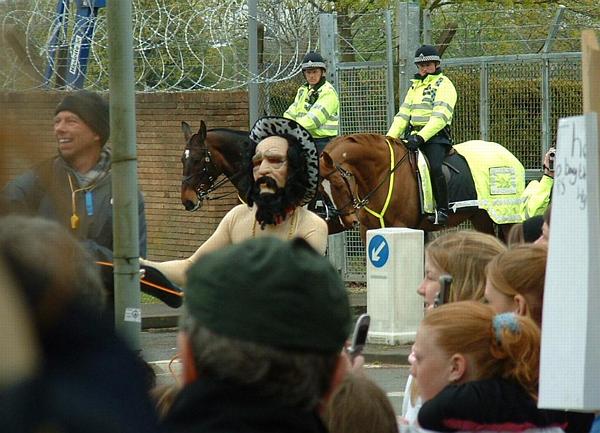
Local teenagers watch statue toppling, police watch me
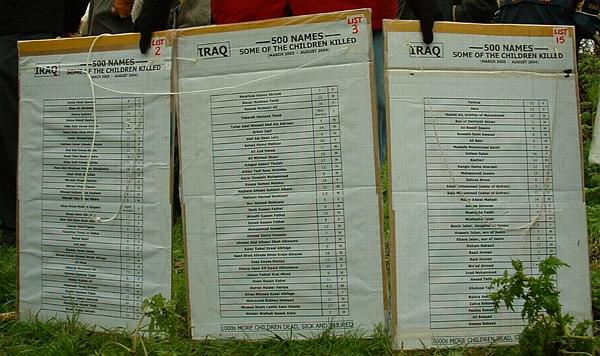
Names of dead Iraqi children
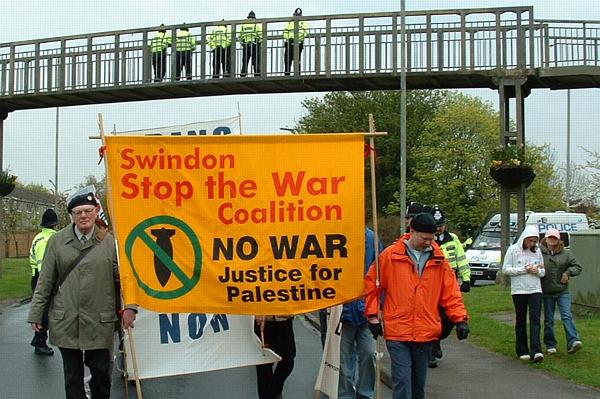
Swindon Stop the War banner
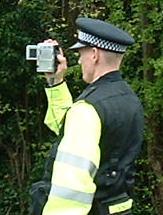
Police filming and photographing everyone

… but you want to keep the price of oil low don’t you?
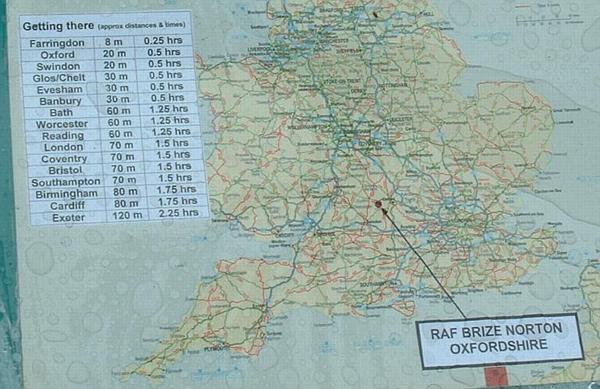
Location of Brize Norton
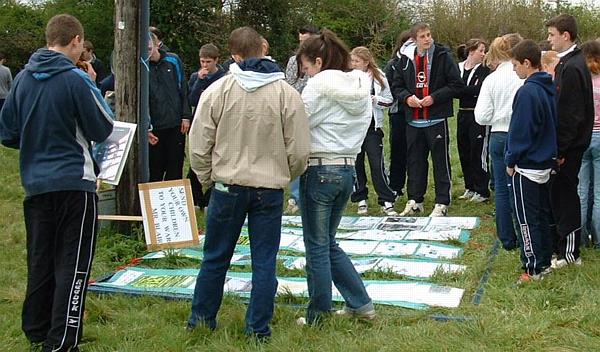
Local teenagers reading peace camp information board

This peace camp respects nature
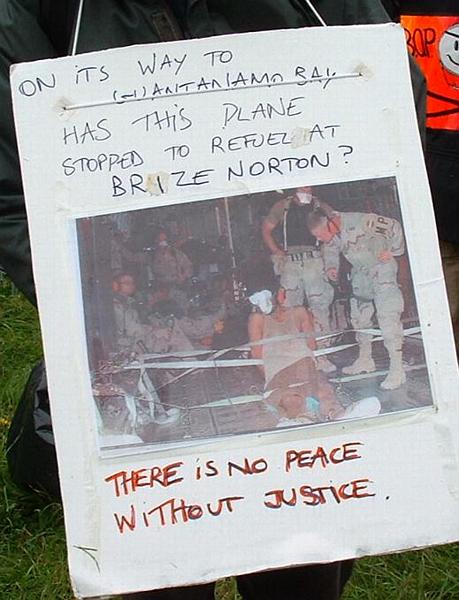
Has this plane refuelled at Brize Norton?
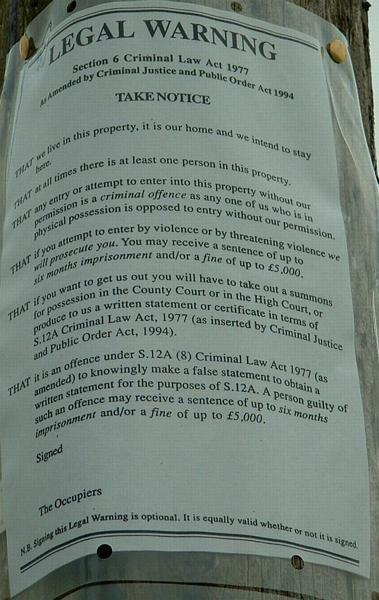
This is our home and we intend to stay here
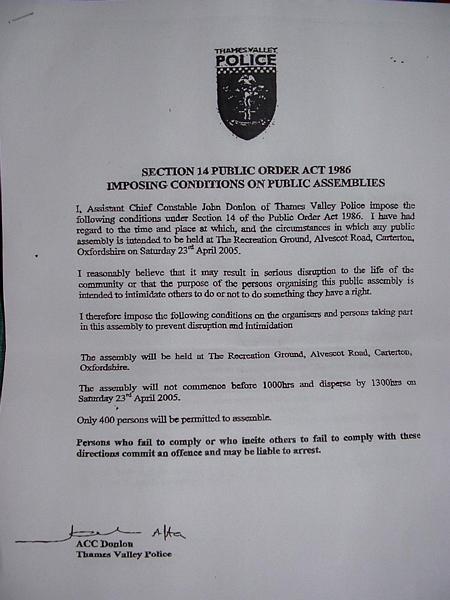
Programme of the day, compliments of Thames Valley Police
There was a huge statue of Tony Blair, complete with manic grin and Pinocchio-style nose, but surely they didn’t think we were going to burn it? It was far too good to burn in my opinion, and toppling statues is far more fun, with the advantage that you get to keep the statue to topple another day.
Somehow, I don’t think the police had done their research on this event and had missed the point completely. If they’d read the publicity for the peace camp which has been circulating on Indymedia and open e-groups for some months, they’d have seen phrases like this:
“We don't want to accuse and condemn - rather to try and enter into some kind of dialogue with anyone willing to talk with us. At Brize, we will mainly be dealing with RAF personnel - 60 per cent of whom are said to have been opposed to the 2003 assault on Iraq, in the first place. But we may also get the chance to talk directly with soldiers bound for Basra.”
and
“We would want to discuss our opposition to Blair's collusion with the present regime in the United States, and how British troops have been drawn into doing its dirty work.”
That isn’t the sort of language used by someone who’s planning to intimidate people.
As the assembling marchers from Oxford, Bristol, Swindon, Faringdon and more were called to order, and were reminded that Carterton had never seen a demonstration before, it became clear that this event was attracting some interest from the locals. Some teenagers were hanging about nearby, and occasionally took the mickey, as teenagers are liable to do, but I sensed no hostility from them, more a feeling that they’d never seen anything like this before and were watching to see if anything exciting happened.
I have no idea what intimidating behaviour the residents of Carterton were expecting that day, but what they saw as the march left the Recreation Ground and turned onto Alverston Road certainly wasn’t the rampaging mob of thugs and vandals that might be implied from the police conditions. Instead, they saw colourful peace flags, placards speaking out against the Iraq war, and a long banner carried at the edge of the march reading “Illegal War – Illegal Orders”. Breach of the Peace samba band and the Red Notes choir took turns to provide entertainment, and the giant Tony Blair statue marked the back of the march.
You could tell that these intimidation tactics were working by the way that the locals lined the pavements, or pressed their faces against the insides of windows, to watch us as we walked past. There were probably as many locals just watching the march as there were marchers.
There were quite a few cameras around to record the day, some wielded by marchers and marshals, some by police, one TV camera, and a few of those cameras with really serious-looking lenses which are normally seen in the hands of newspaper photographers. But most of the cameras were in the hands of the local onlookers – middle-aged people standing at their front gates, shoppers and workers in the town centre, and a growing group of teenagers who were walking alongside the march with their camera phones. A dancing man wearing only a body stocking, a strategically-placed bag and a bearded mask, was especially popular with the onlookers.
This is where the point of one of the police conditions became clear – no leafleting.
The peace camp is part of an outreach programme to make sure military personnel know their rights regarding conscientious objection. They don’t need to be a pacifist to conscientiously object, nor have any specific religious objections to war. They can object to serving in a war if they believe that that war is wrong, which becomes essential in the light of the current Iraq war, when taken in context with the ruling of the Nuremburg trials that “only following orders” is not a valid defence against a charge of war crimes.
But the armed forces don’t go out of their way to tell the personnel about their rights in this respect, or about their right to have a declined application for CO status referred to the Advisory Committee on Conscientious Objection. In fact they don’t tend to even tell the personnel that this committee exists – how can you appeal to something when you don’t it exists?
When I spotted a policeman having a stern word with a lady holding a bundle of leaflets, it became clear that this particular condition on the march was to prevent this sort of information leaking into the community.
At the end of Brize Norton Road, we assembled for a rally outside the gates of RAF Brize Norton. Marchers and local teenagers alike mixed and listened to speeches, while police on horseback stood guard outside the base, and a camera mounted on an aerial platform within the walls of the base filmed us all from on high.
Once the speeches had been made, willing volunteers seized ropes attached to the statue of Tony Blair, and pulled it to the ground in mimicry of the stage-managed toppling of the statue of Saddam in Baghdad two years ago, whilst the local teenagers hungrily captured the scenes on their camera phones.
We made ready to set off on the second part of the march, back the way we had came through Carterton and to the peace camp, but apparently the police didn’t think it was time for the march to start yet. So the samba band and the choir again took turns to entertain the waiting crowd, which was by now so mixed that you couldn’t possibly draw a line between marchers and locals. Despite the restrictions, I’m sure a few leaflets made their way into the locals’ pockets during this time, some no doubt to be thrown away, but others to be taken home and discussed with friends, family and colleagues.
I spotted two ladies carrying boards with the names of Iraqi children killed between March 2003 and August 2004 and got talking to them about media coverage of demonstrations, and about Indymedia. One of them told me how disappointed she was with the lack of coverage of the 19th March demo in the corporate media. I told them I was planning to publish my photos and report to Indymedia and tried to explain how open publishing works. They seemed very pleased to learn that they would be able to re-use coverage of this event from Indymedia in their church newsletter (providing they check whether individual authors have placed their own conditions on their work).
Finally the march set off again, back through Carterton town centre. The locals were still there, lining the street to watch us as if we were some kind of royal procession, and the teenagers were still with us all the way to the peace camp.
Although page five of the police conditions stated that the final assembly of the day would take place on a public footpath, we actually ended up in a field which had been claimed by the peace campers as their home under section 6 of the Criminal Law Act 1977 (as amended by the Criminal Justice and Public Order Act 1994). The police, who had been sticking to the marchers like glue up till this point, didn’t follow us into the field. I did spot two small groups patrolling part of the field later, one on foot and another on horseback, but they stayed away from the part of the field where the tents and marchers were, paying more attention to the hedgerow marking the perimeter of the air base.
Volunteers served tea, coffee, cakes and soup to the marchers and teenagers, in exchange for donations. A large display lay on the ground, providing information about RAF Brize Norton, its location, pages from the RAF web site, news reports and more to draw the link between this air base and the crimes being carried out in the name of the “war on terror”. Many of the local teenagers stood reading the display for a while.
There were a few more speeches at the peace camp, followed by an open mic session, and a music workshop later in the evening. The feeling amongst the marchers and peace campers as the locals were drifting back into Carterton was one of annoyance at the last-minute and excessive restrictions imposed by the police, but also a sense of achievement which could not be damped by the light rain which had been falling on us all day.
We had held our march, most of the town had seen us, and they could see that far from being something to be feared or hated, we were a diverse group of people channelling our anger at the world’s wrongs into a colourful, noisy, and non-threatening spectacle. Now they know that we’re not two-headed commie traitors, they’ll be more open to the ideas and support being offered by groups like Military Families Against War.
It should also raise questions about the need for excessive police restrictions on events such as these. A comparison of the restriction notices with the nature of the march itself as recorded by the cameras and phones of the people of Carterton, can only show that the approach taken by the police was well over the top.
There is much more work to be done on this front, but this event can be counted as a small victory in the ongoing campaign.
More information:
 http://www.fairfordpeacewatch.com/brizenortonpeacecamp.html
http://www.fairfordpeacewatch.com/brizenortonpeacecamp.html See also
 http://bristol.indymedia.org/newswire/display/22508/index.php
http://bristol.indymedia.org/newswire/display/22508/index.php Quote: “The marchers were a terrifying assortment of toddlers, grannies, idealistic youth, old hippies, and, most scarily, very normal looking people. The anarchist black bloc & other fence trashers have clearly perfected their disguise. Accompanied by a small but rhythmic samba band, they paraded through town, and the town came out too….to gawp, heckle a bit, take photos, sometimes join in, but most of all to disrupt the normal life of the community by walking alongside blocking footpaths, swelling numbers, AND NOT SHOPPING. Local youth were particularly excited by this new phenomenon, with the irony that those who joined in also found themselves subject to the Sections 12 & 14.”
More about the peace camp on Bristol Indymedia -
 http://bristol.indymedia.org/
http://bristol.indymedia.org/ 
Comments
Display the following 8 comments